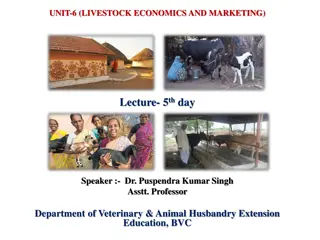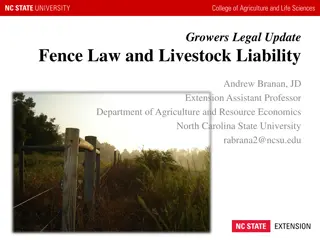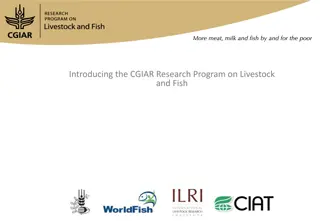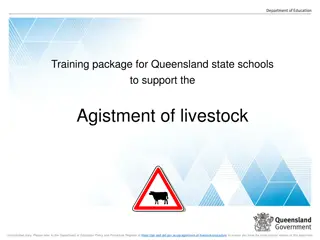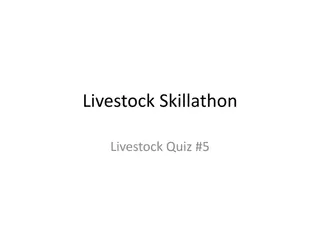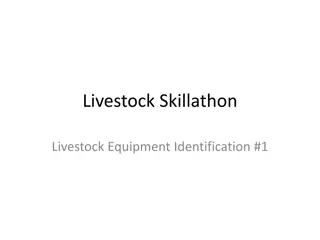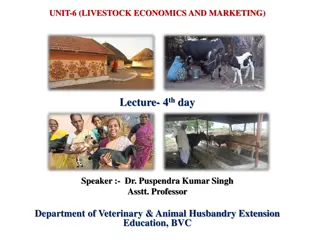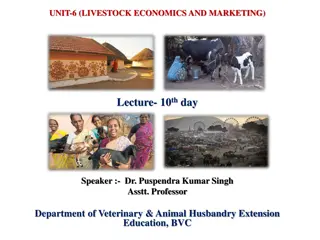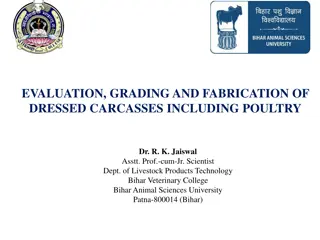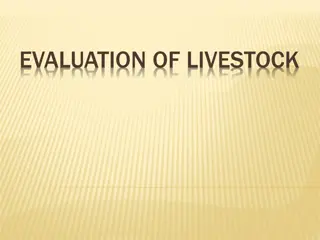Livestock Economics and Marketing: Market Information and Institutional Approach
Market information plays a crucial role in livestock economics and marketing by providing essential knowledge on prices, quantities, and stocks, aiding decision-making for farmers and market intermediaries. It encompasses market news and market intelligence. The collection of market information is done by official and non-official agencies, such as government bodies and industry associations. The institutional approach to marketing involves studying various marketing agents and intermediaries to understand their roles and operations in the market.
Download Presentation

Please find below an Image/Link to download the presentation.
The content on the website is provided AS IS for your information and personal use only. It may not be sold, licensed, or shared on other websites without obtaining consent from the author. Download presentation by click this link. If you encounter any issues during the download, it is possible that the publisher has removed the file from their server.
E N D
Presentation Transcript
UNIT-6 (LIVESTOCK ECONOMICS AND MARKETING) Lecture- 9thday Speaker :- Dr. Puspendra Kumar Singh Asstt. Professor Department of Veterinary & Animal Husbandry Extension Education, BVC
Topics covered Market information, financing, risk bearing, minimization of risks (speculation and hedging).
Market information Communication or reception of knowledge regarding various aspects which affect marketing of goods and services of products like prices, quantity brought into market for sale, stocks (both present and past), etc. Facilitates the farmers in taking decisions regarding when and where to sell their products. For market intermediaries, market information helps them to decide upon volumes to purchase, volume to sell and also volume of goods to stock. Essential for government for smooth conduct of the marketing business and for protection of all the groups of persons associated with marketing. Market information can be classified into market news and market intelligence. 1. Market news : Market news constitutes presence of current information on prices of commodities, market arrivals, stocks, direction of outflows, etc. As market news given current information, it becomes out-dated quickly and requires updating at frequent intervals. Market news helps the farmers in planning their sales. 2. Market intelligence : Market intelligence is historical record of what happened in the past. It is the study of market behaviour that was observed in the past pertaining to price trends, arrivals over time, stocks over time, etc. Market intelligence is crucial as analysis of the past helps various stakeholders to take decisions about the future.
Market information is collected by both official and non-official agencies. These may be public or private entities. The major role in India in regard to collection of market information rests with government agencies, like state marketing departments, state agricultural marketing boards and directorates of economics and statistics of the state and central governments. In case of livestock products, state milk marketing federations and National Egg coordination Committee (NECC) collect market information pertaining to milk and milk products and eggs, respectively. The sources from which market information can he obtained are newspapers; magazines and publications like Bulletin of Agricultural Prices, Agricultural Prices in Indian, Agricultural Situation in India, etc.; Government agencies reports like Reports of Bureau of Economic and Statistics, the Directorate of Marketing and Inspection, Directorate of Economics and Statistics; mass media like radio and Television.
Institutional Approach to marketing In this approach, we study various marketing agents and intermediaries and examine their form, organization and mode of operation. Middlemen Speculative Middlemen Agent Processor Merchant Commission agents Retailers Facilitative Middlemen Wholesalers Broker Local buyer Full-time
Merchant middlemen : Merchant middlemen can be retailers or wholesalers. Retailers purchase the requisite lots of goods from wholesalers and dispose the products to the ultimate consumers. Wholesalers buy commodities in bulk from producers or traders and sell to processors or retailers. Wholesalers can be local buyer or full-time wholesaler. Local buyer buysthe product in the producing area, directly from producer and shifts the product to larger cities or town area, where they sell to another wholesaler or processor. Full-time wholesalers specialize in only limited number of products and generally are situated in larger towns and cities.
Agent middlemen : Agent middlemen act only as representative of their employer. They do not actually own the product, but sell or purchase on behalf of their employer only. They simply help in the negotiations activity and get commission in terms of fees. Agent middlemen are of following two types i. Commission agents : Commission agents are granted more powers by their employers. They take over the physical handling of the produce, arrange for terms of sale, collect the returns, deduct his fees/commission and remit the balance to his employers. ii. Brokers : Brokers do not have physical control over the product and their role in restricted only to price negotiations. They bring buyer and seller together and charge brokerage, which is a fixed sum of amount for helping to perform a particular marketing activity. They collect relevant information in the market on the sales of the commodity, deduct their commission (a fixed proportion of value of commodity) for their services and remit the balance to the seller.
Processors : Processors change the form, shape, quality, taste, colour, etc. of raw produce. They generally buy the produce from wholesaler or agents. Speculative middlemen : The role of speculative middlemen is important for agricultural/livestock products, because of seasonality in production of such produce. They procure and purchase the produce with the aim of making major profits with future price movements. The process of making profits from future price movement is called speculation. Facilitative middlemen : They generally provide physical facilities in marketing or trading by providing services in transporting, loading/unloading, storage, etc. They also provide data on prices, supply, demand of a commodity and guide the rules of trading among market intermediaries.
Commodity of channel distribution approach This approach studies the passage of a commodity through different channels of distribution as it moves from the point of production to the point of ultimate consumption. Marketing channel is the route or path through which a commodity reaches from producer to the consumer. These can be many alternative routes available for the same commodity. The marketer/producer has to decide which path to choose to maximize profit and minimize the price paid by consumer
Marketing channels for different livestock products are given below: Marketing channels for milk 1. Producer -Consumer 2. Producer Milkman - Consumer 3. Producer -a Milk Mart -a Sweet seller -a Consumer 4. Producer -a Milkman - Cooperative Society - Consumer 5. Producer -a Cooperative Society - Processor -a Retailer Consumer Marketing channels for eggs 1. Producer -a Consumer 2. Producer -a Egg assembler Wholesaler - Retailer -- Consumer 3. Producer -a Egg assembler a Retailer Consumer 4. Producer - Hawkers -a Consumer 5. Producer Agent middlemen - Wholesaler - Retailer - Consumer 6. Producer - Wholesaler Retailer - Consumer 7. Producer - Cooperative Marketing - Society - Wholesaler -a Retailer Consumer
Marketing channels for live poultry 1. Producer - Consumer 2. Producer- Wholesaler- Retailer - Consumer 3. Producer -a Cooperative -a Marketing Society - Retailer - Consumer 4. Producer -a Wholesaler - Hotels and Institutes Retailer Marketing channels for live animals 1. Seller -Trader - Buyer 2. Seller - Middlemen- Buyer 3. Trader - Middlemen-Buyer 4. Trader- Buyer






